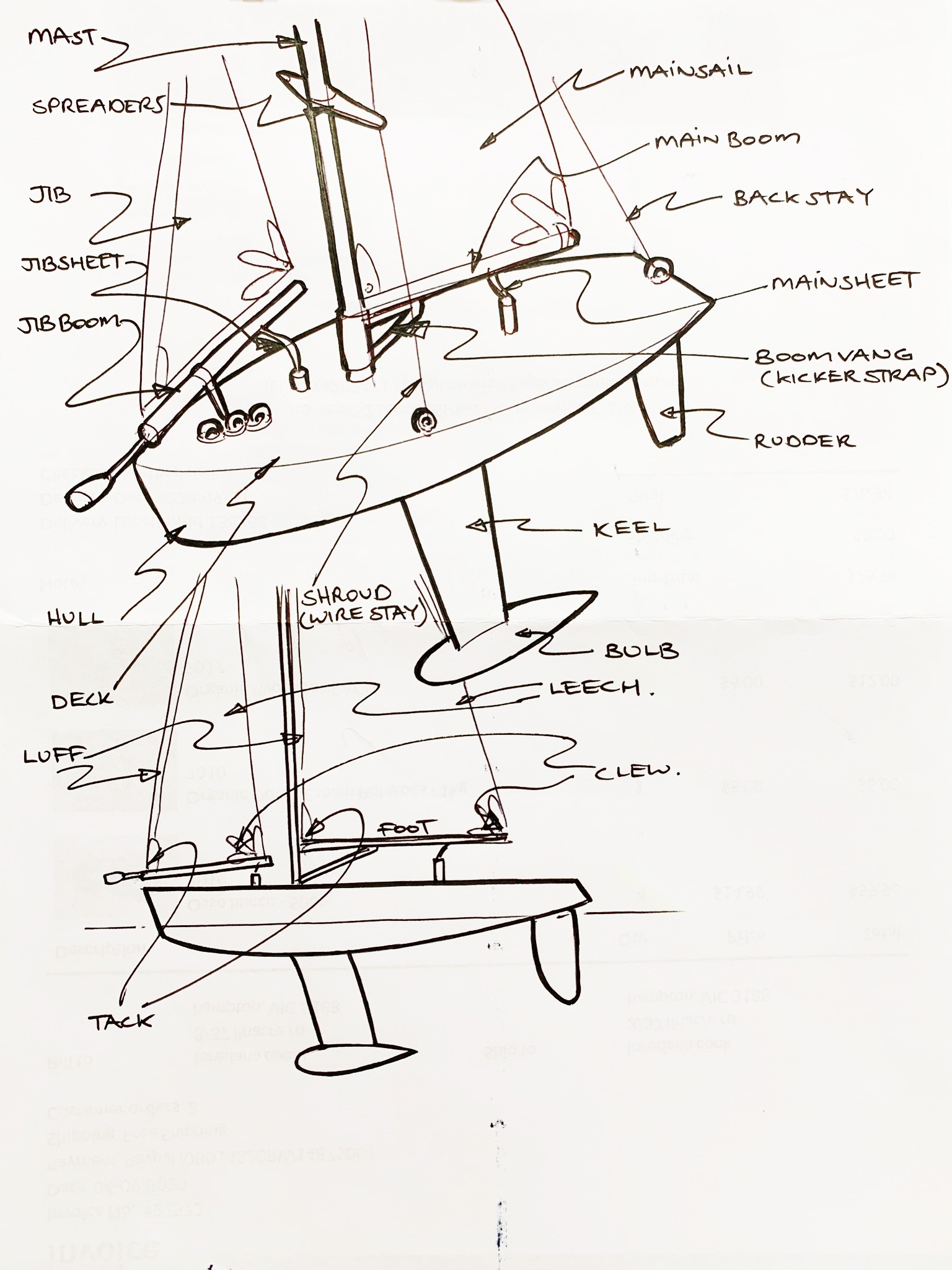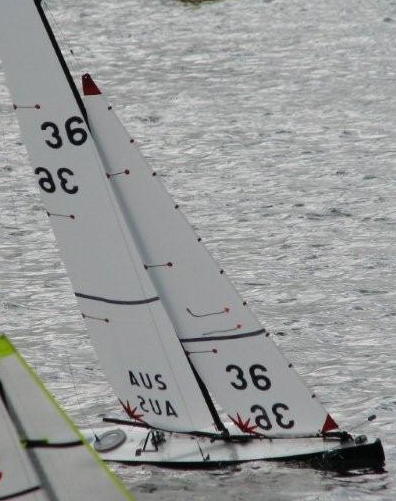
Parts of the boat that are used to move it along.
Let' s start at the bottom and work up:
The heavy wing thing at the bottom of the boat, in the centre is called the keel.
The Keel prevents the boat from falling over when the wind pushes on the sail, and also helps the boat go forward with the sails set, it is like a seesaw, wind on sail versus keel!
The wing at the back of the bottom of the boat is called the rudder.
This directs the flow of the water and steers the boat, it cuts through the water like a knife, if its turned too much it drags through like a spoon and that’s slow as well!
Sides
The front , pointy end of the boat is known as the bow.
The back blunt end of the boat of the boat is called the stern.
The left side of the boat is called port
Andthe right side is starboard.
On a boat
If something is behind another object it is aft of it, while if it is in front of something it is forward.
Consequently the keel is'forward of the rudder' while the rudder is 'aft of the keel'.
MAST AND SAILS
The sails are the engine of the boat, so a good set is a good start!
As with the engine for motoring, they are quite complicated but once you know what is what you can set them better and go more efficiently.
THE JIB SAIL
The jib sail, is the sail at the front of the boat.
The front corner of it is the tack and is attached to the bow.
The aft end is called the clew and is attached to the jib boom or jib sheets to control the shape of then when you set the sail.
We do not have ropes on boats typically, save for tying the boat up, we have what we call Sheets to control trim and halyards to lift sails up the mast.
Called standing and running rigging, some move and some do not as name indicates a little!
To get the sail up, we have a jib halyard that is attached to the head (top) of the sail.
The front edge of the sail is called the luff.
By tightening the jib halyard you tighten the luff.
Between the tack and the clew is the foot of the sail, this is tightened by the jib clew being moved on the boom or by the jib sheets.
The mast is where the halyards are led to.
As well as the jib halyard you also have the main halyard that pulls the mainsail up and down.
THE BOOM
Attached to the mast at right angles is a straight piece of metal called the boom.
This is where the foot of the mainsail goes, on the outer end the clew attatches and pulls in and out to change sail shape and flatten the sail.
The main and jib sheets are used to pull the sails in to acelerte or slow down.
Going down wind you will want to let them out, while sailing close to the wind you will tighten them.
To stop the boat you let them out and steer into the wind.
The Cunningham pulls down on the base of the mainsail luff and keeps the sail tight from top to bottom.
So the main halyard pulls the sail up while the Cunningham pulls it down.
SAILING IN STRONG WIND
If the wind gets too strong, you sometimes want less sail up.
It is like changing gears in a car, and remember tipping over is less forward speed!
Sailing can be fun in stronger winds!
WINDWARD AND LEEWARD SIDE
The side of the boat facing the wind is the windward side and the side facing away is the leeward side.
Generally speaking the boat will lean away from the wind, so the leeward side will be the lower side of the boat when sailing.
Andrew Says,
Best advice is to put the boat in the water, don’t worry about theory or terms too much.
With the boat in the water, you want to go somewhere, the bar or a race course marker.
If the sails are flapping, pull them on and steer where you want to sail to.
When they are fully pulled in and still flapping then you cannot aim to it, then the wind is in the wrong direction and you may have to sail zig zags (called tacking) to get to the point.
When you head towards your point and the sails are not flapping, let them out to try to make them flap, if they will not, then you are ‘running’ away from the wind and fully powered up.
The only way to slow and stop a boat is to let the sails out.
So if you are ‘running’ at full speed , the only way to slow is to turn towards the wind, making the sails flap, until the boat slows and stops.
To practice and also learn how to slow the boat for docking, pick a marker buoy and try stopping your boat with the bow lightly touching it, then accelerating away.
If you must know more about theory at this point the best way I explain it is that,
A boat does not move forward.
They move less sideways and appear to go forward.
So if you have a boat with a knife like bow and spoon like shaped stern and big flat spoon sides with the sails flapping like a flag, what happens?
A flag flapping flows back from a flag pole or mast.
Your boat would be pushed back.
The boat does not like the drag from the big spoon stern and will turn as it goes backwards in the wind.
It likes the side of the boat slightly more but that’s a really long flat surface to push through the water as well.
As the boat speeds up going backwards, then goes sideways, the knife like bow is a much more attractive and easy way!
So the boat to converts the leaning over energy into forward motion!
And so the boat seems to move forward!
That’s all before the sails are pulled in even!
Then if sails pulled in to stop the front edge flapping, that’s the accelerator.
But pull them in too much and it is like to much accelerator and loosing grip!
If you are not able to use all the power, the boat tips and goes more sideways than sideways forward.
The boat is tipping with sails on too much, you will be pulling on the (until now unused) rudder to steer where you wanted to go.
Let the sails off until they flap then readjust.
Steering is for small corrections and remember the rudder is a knife in the water and works like a bike front wheel.
If you sit motionless on your bike on a hill, lift your feet of the ground with the steering straight, the bike will roll forward.
If you sit on the bike on the same hill with the steering turned, you will roll off the bike!!
So steering in the middle as much as you can is as safe as possible and as fast as possible!
And letting the sail out to keep the hull trimmed to use all the power is the way to sail fast safely!
Same for 20 cm or 20 metre long sailboats!
Enjoy!
Andrew




